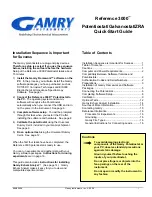
Navigator 500
Sodium analyzer
Appendix A – Troubleshooting
OI/ASO550–EN Rev. G
75
A.2 Calibration pass and fail limits
After a two point calibration, the percentage Slope is calculated.
The calibration pass limits and their meanings are shown
in Table A.2.
Any unexpected results may be due to the standard or reagent
solutions. If doubts exist about the integrity of these solutions,
replace them with freshly prepared solutions in the early stages
of the fault-finding investigations.
The accuracy of the wet-section is affected by the condition of
all the solutions involved, one or more of which can be
incorrectly made or contaminated.
Measuring the pH of the effluent from the flowcell indicates the
amount of buffering of the sample. The minimum pH depends
on the minimum sodium concentration, but the pH value is
calculated as shown below.
pH must be greater than pNa + 3, so ideally at:
100 µg kg
-1
Na+, the pH must be greater than 8.4
10 µg kg
-1
Na+, the pH must be greater than 9.4
1 µg kg
-1
Na+, the pH must be greater than 10.4
0.1 µg kg
-1
Na+, the pH must be greater then 11.4
Check mechanical components involved with liquid handing
systematically for leaks or blockages as they change the
chemical conditions around the electrode. Most problems are
found to be associated with the chemistry, electrodes and the
liquid handling section.
Note.
If the reagent is allowed to become completely
exhausted, the reading may be very erratic due to the lack
of ionic strength adjustment of the high purity sample.
Percent slope
Action
Slope > 110 %
Calibration unacceptable.
New coefficients ignored and the transmitter
continues to use the last known good
coefficients.
Check correct calibration standards have
been used.
Check the correct calibration standard
values have been entered into the
transmitter.
80 % <Slope <110 %
Calibration acceptable.
New coefficients are used saved and the
transmitter uses these values for
subsequent calculations.
Slope < 80 %
Calibration unacceptable.
New coefficients are ignored and the
transmitter continues to use the last known
good coefficients.
Check the correct calibration standards
have been used.
Check the correct calibration standard
values have been entered into the
transmitter.
If solutions are satisfactory, replace the
electrode pair.
Table A.2 Calibration pass limits












































